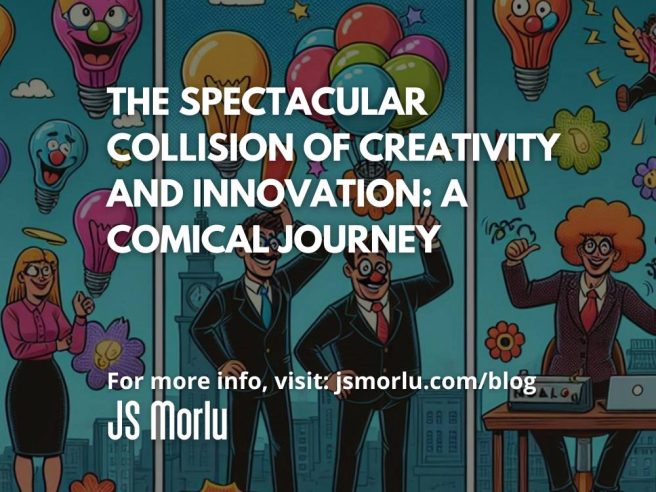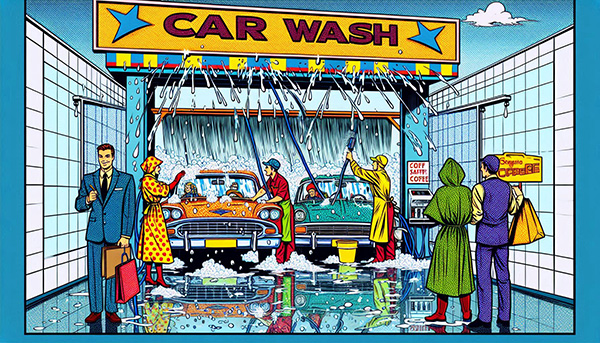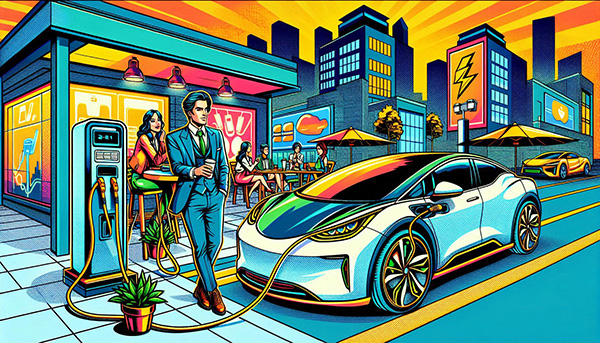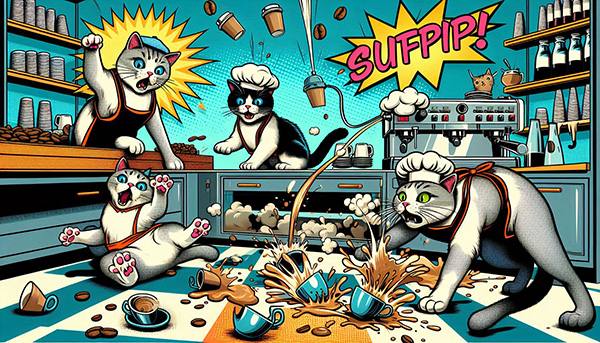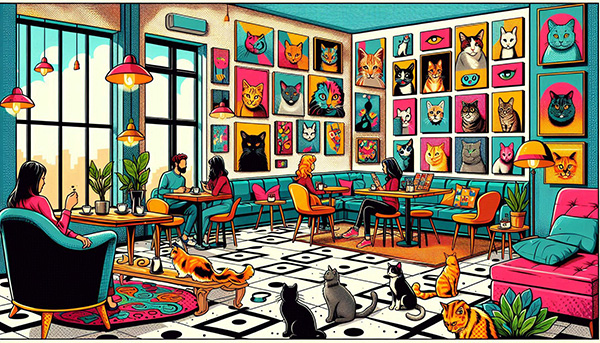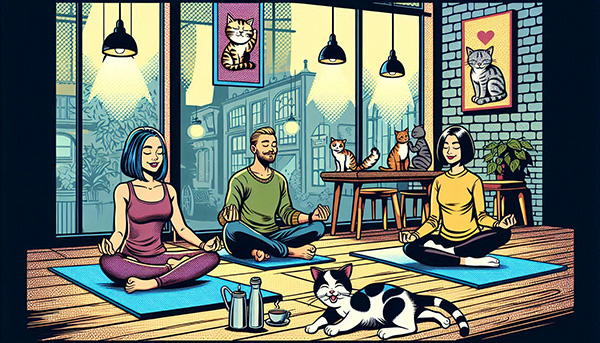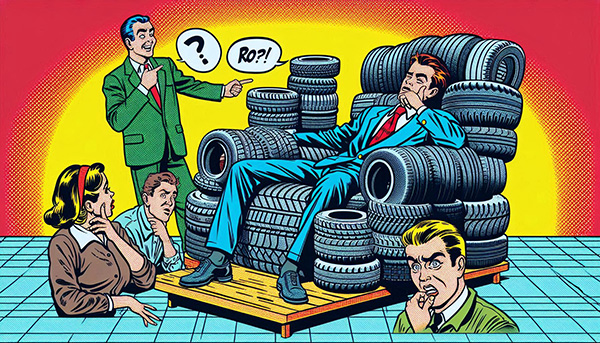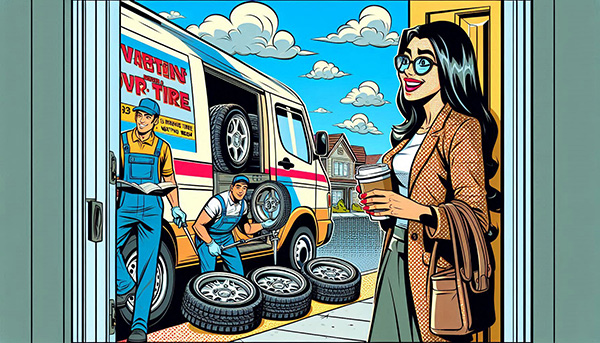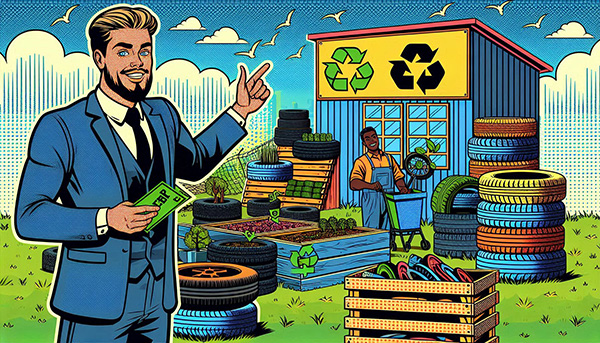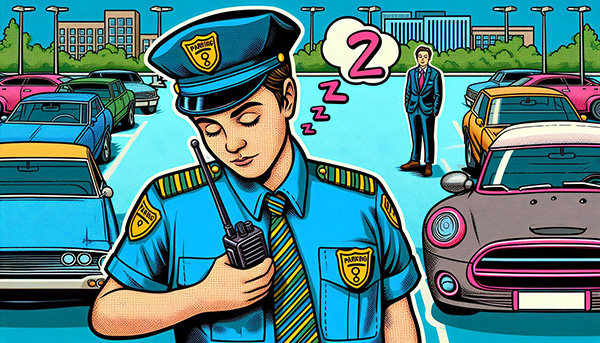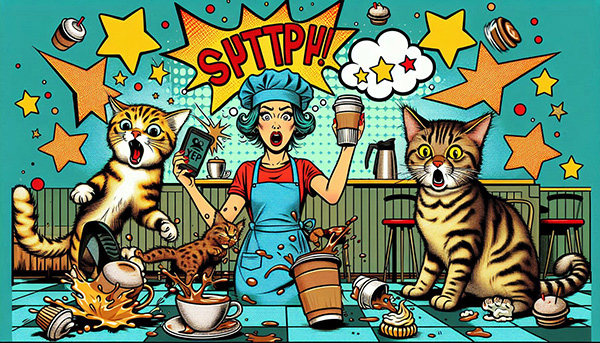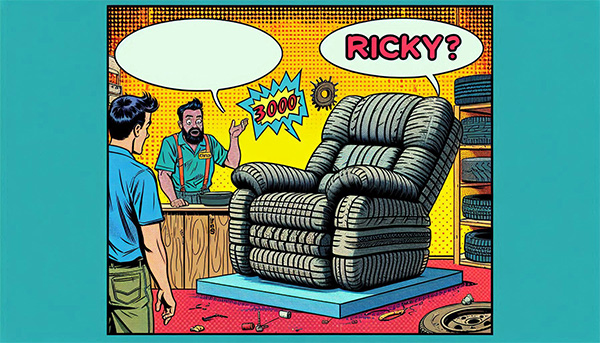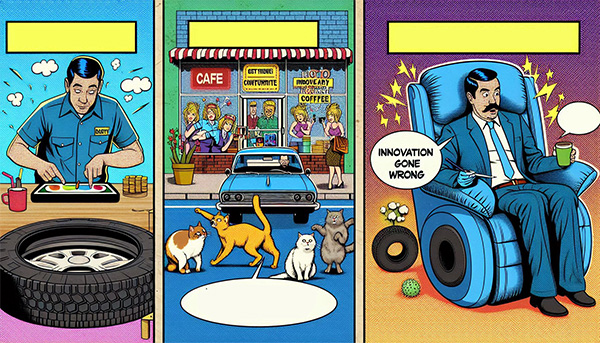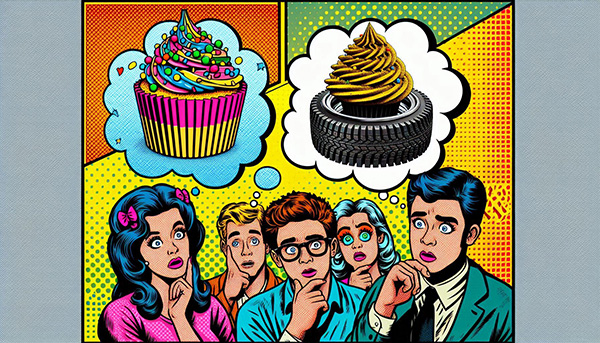By: John S. Morlu II, CPA
A Tale of Two Talents: When Creativity Meets Innovation
In the bustling world of small businesses, creativity and innovation are often tossed around like confetti at a wedding—everyone wants a piece of the action. But let’s face it: not everyone understands the difference between the two. It’s like mistaking a chef for the inventor of the toaster—sure, both can produce something hot, but they’re working in entirely different kitchens.
Creativity is the art of improving what’s already there—tweaking processes, rethinking old ideas, and finding fresh angles to tackle familiar problems. It’s like slapping a new coat of paint on your coffee machine, attaching a label, and calling it a “Cappuccino Wizard.” It’s clever, practical, and maybe even impressive, but the heart of the machine is still brewing the same old cup. Innovation, on the other hand, is the wild cousin who doesn’t just think outside the box—they throw the box away entirely. Innovation might take that coffee machine, toss it into a 3D printer, and turn it into a self-watering plant pot. Both creativity and innovation are essential for success, but they operate in different spheres with distinct outcomes.
This satirical exploration dives into the worlds of three small business owners, where entrepreneurial insight is blended with humor. Meet Barry, Carla, and Greg—three characters navigating the fine line between creativity and innovation. Sometimes they stumble upon gold, and other times, they stumble over their own feet. You’ll laugh, you’ll cringe, and you’ll learn a little something about what happens when creativity and innovation collide—sometimes with spectacular success, and other times, with downright hilarious disaster.
So, buckle up and get ready to witness the magic (and occasional madness) of small business ingenuity.
Chapter 1: Barry’s Parking Paradise – Creative Genius or Just Bored?
Meet Barry, the proud owner of Barry’s Parking Paradise, a modest empire of asphalt in the heart of the city. To most, it’s just a place to park, but to Barry? It’s a blank canvas of endless possibilities. Barry, like many small business owners, believes in the power of creativity and innovation. His dream? To transform his parking lot into a hub of activity, revenue, and, dare he say, magic. But as you’ll soon learn, there’s a fine line between creative genius and just plain… bored.

Barry’s Creativity That Missed the Mark
One sweltering afternoon, Barry was lounging in his office (a converted parking booth with a fan that only worked on Tuesdays) when he noticed his parking attendants scrolling through their phones for the umpteenth time that day. Then, it hit him—a lightning bolt of brilliance! “What if,” Barry mused, “I had them offer security services too? Two birds, one stone!”
The idea was simple: Why not have the attendants keep an eye on the cars while they stood around all day? After all, they were already there, so why not slap a shiny new badge on them and call it security? In Barry’s mind, this was a masterstroke of efficiency. Suddenly, his teenage parking attendant, Timmy—who hadn’t been fully awake since 2019—was not just a part-time parker but a guardian of the asphalt, protector of Hondas and Hyundais alike.
Was Barry proud? Absolutely. Was it creative? Well, technically. But was it innovative? That’s where things get a little hazy. Sure, Barry added a new task to the attendants’ job description, but did it revolutionize anything? Not really. It was like giving a mall cop a whistle and declaring them the chief of police. Timmy still spent most of his shift on TikTok, and the only thing he guarded was his personal best on “Candy Crush.” But hey, at least Barry tried.
Creativity That Actually Worked: Park & Shine
Barry’s first successful creative endeavor happened on a particularly rainy Monday when he noticed all the cars in his lot just sitting there—sad, muddy, and definitely not paying him extra for the privilege of parking. That’s when the idea hit him: Park & Shine. Why not offer car washes while customers went about their errands? It wasn’t exactly rocket science, but it was a way to add value to the service without completely overhauling the business.
Customers loved it. They’d drop off their cars in the morning, run to grab a coffee or do some shopping, and come back to find their vehicles sparkling like they’d just rolled off the lot. Barry wasn’t reinventing the wheel, but he was making the wheel shinier. It was the kind of simple, effective creativity that customers appreciated—and more importantly, paid for.
Suddenly, Barry’s lot was full of cars and suds. He wasn’t just running a parking lot anymore; he was operating a mini car wash empire. The Park & Shine service brought in more revenue, and Barry’s business was booming. It was creative, yes, but also practical—something even Timmy could get behind (when he wasn’t napping behind the minivans).
Innovation That Worked: Electric Vehicle Charging Stations
Barry’s true brush with innovation came after a conversation with one of his more eco-conscious customers. The customer had just bought an electric vehicle (EV) and was lamenting the lack of charging stations in the city. And just like that, the wheels in Barry’s head started turning faster than Timmy could swipe left on Tinder.
Within months, Barry installed several EV charging stations, turning his once-forgotten parking lot into a crucial pit stop for electric car owners. He didn’t just add a new feature—he completely transformed his business. Now, Barry wasn’t just offering a place to park; he was offering a service that didn’t exist anywhere else in the neighborhood. His lot became a magnet for EV drivers, and the steady hum of charging cables was music to his ears (and his wallet).
But Barry didn’t stop there. Ever the hustler, he struck up partnerships with nearby coffee shops to offer discounts to drivers while they waited for their cars to charge. Suddenly, his customers weren’t just parking—they were sipping lattes and browsing boutique stores while their vehicles charged up. The lot became a hub of activity, a destination. And Barry? Well, Barry was officially an innovator.
It was a win-win: More foot traffic for local businesses, happier customers, and a greener city. For the first time, Barry had done more than slap a fresh coat of creativity on his parking lot—he’d genuinely innovated, and his business was thriving because of it.
Chapter 2: Karen’s Krazy Kitten Kafé – Where Coffee Meets Chaos
Just down the street from Barry’s asphalt kingdom, Karen is busy running Karen’s Krazy Kitten Kafé, a place where lattes and felines coexist—somewhat peacefully. Her café has everything a cat lover could want: kittens in cozy nooks, soft jazz playing in the background, and, of course, plenty of cat fur sprinkled into every muffin. Business was already purrfect, but Karen had bigger dreams. She didn’t just want to serve coffee alongside cats; she wanted to revolutionize the entire café experience.
But as you’ll soon see, sometimes dreams come with claws.
Innovation That Failed: Cats as Baristas
One day, while refilling the kibble bowls, Karen had what she believed was an epic breakthrough: “What if the cats could serve coffee? I could fire my baristas, save money, and attract even more customers with the sheer adorableness of it all!”
Now, most people would stop and think, “This is absurd.” But Karen? Karen saw an opportunity. Out went the human baristas, and in came Muffin, Biscuit, and Pickles, three of her fluffiest employees, all outfitted with miniature aprons and hats. The plan was simple: train the cats to “assist” customers by delivering their orders. Easy, right?
Wrong. What followed was nothing short of feline-fueled chaos. Muffin refused to leave her sunspot, Pickles spent more time attacking the espresso machine than operating it, and Biscuit—bless his heart—simply curled up in the milk frother. Coffee was spilled, orders were delayed, and customers found themselves on the receiving end of claws rather than cappuccinos.
Furious Yelp reviews poured in:
- “I ordered a mocha and left with claw marks.”
- “This café is where chaos goes to take a nap.”
- “If I wanted a disaster, I’d let my toddler make me coffee.”
While the idea of cats as baristas might have sounded like a whimsical innovation, the reality was more like a scene from a horror movie—except with more fur and spilled milk. Karen learned the hard way that not all innovations are meant to be… functional.
Creativity That Worked: Feline-Themed Art Shows
Humbled but undeterred, Karen decided to take a step back from the grandiose and return to her roots: cats and coffee. That’s when she came up with a much simpler, yet brilliant idea: Feline-Themed Art Shows.
Every month, Karen invited local artists to showcase their cat-inspired artwork in her café. Paintings of moody tabbies, sculptures of majestic Maine Coons, even the occasional abstract cat butt—Karen’s café transformed into a cultural mecca for art lovers and feline fanatics alike.
The best part? It didn’t involve trying to teach cats how to steam milk. The café stayed true to its original concept, but the art show added a fresh twist that attracted a broader crowd—art enthusiasts who didn’t even own cats came in for the creativity and stayed for the coffee (served by actual humans, this time). Business boomed, and the walls of Karen’s café became as famous as the cats themselves.
And the customers? Well, they were far more willing to overlook the occasional hairball when they had captivating cat portraits to distract them.
Innovation That Worked: Cat Meditation Sessions
But Karen didn’t stop there. Her crowning achievement—an actual innovative idea that worked—was the introduction of Cat Meditation Sessions.
“Why should yoga studios have all the fun?” Karen thought. And so, once a week, the café transformed into a sanctuary of calm, complete with soothing music, soft lighting, and the gentle purring of the café’s resident cats. Customers were invited to sit, breathe, and let the calming presence of Muffin, Biscuit, and Pickles (when they weren’t busy napping in the milk frother) help them achieve true inner peace.
Imagine it: You’re sitting cross-legged on a mat, eyes closed, feeling the tranquility wash over you, when suddenly a warm, fuzzy kitten curls up in your lap. The stresses of the day melt away. Sure, sometimes Pickles would get a little too curious and swat someone’s water bottle, but it only added to the experience.
The Cat Meditation Sessions were a hit. Wellness enthusiasts, corporate professionals, and stressed-out city dwellers flocked to the café for their weekly dose of feline Zen. Karen had created something truly unique—an experience no other café could offer. It wasn’t just about coffee anymore; it was about wellness, mindfulness, and the gentle purring of a cat in your lap.
Karen had found her sweet spot between creativity and innovation. The Cat Meditation Sessions tapped into the lucrative wellness market, and soon enough, the café had a waiting list for each session. The innovation wasn’t just functional; it was profitable.
Innovation is risky, as Karen learned when she tried to turn her cats into baristas. But when it’s done right—like with the Cat Meditation Sessions—it can set a business apart from the competition. Meanwhile, creativity doesn’t have to be flashy; sometimes, a simple twist, like Feline-Themed Art Shows, can attract a new audience and keep things fresh.
And remember: Sometimes it’s best to let the humans handle the coffee.
Chapter 3: Ricky’s Tire Wonderland – When Innovation Goes Rogue
Ricky, the proud owner of Ricky’s Tire Wonderland, started with a humble tire shop where the biggest excitement was whether a customer wanted all-season or performance tires. It was a quiet, predictable business—until Ricky attended one of those motivational business seminars. You know, the kind where they tell you to “disrupt your industry” and “think outside the box.” Well, Ricky took that advice and ran with it. Unfortunately, he ran straight into a wall… made of tires.
After the seminar, Ricky became obsessed with innovation. But as you’ll soon discover, not all innovations are created equal. Some should remain locked away in the brainstorm vault for eternity.
Innovation That Failed: The Tire Lounger 3000
Ricky’s first foray into innovation was the now-infamous Tire Lounger 3000—a recliner made entirely out of old tires. “Eco-friendly! Durable! Comfortable!” the flyers claimed. But what those flyers didn’t mention was the fact that lounging on a pile of tires was about as comfortable as napping on a stack of bricks. And the smell? Well, let’s just say if you’ve ever wondered what the open road smells like after a summer heatwave, you could experience it firsthand from the comfort of your very own Tire Lounger 3000.
Ricky envisioned customers kicking back and relaxing on these rubbery recliners, but reality had other plans. People who came to his shop for a new set of tires left with lingering back pain, complaints about the “burnt rubber stench,” and absolutely no interest in buying Ricky’s tire-themed furniture. Soon, his showroom became an accidental junkyard, filled with unsold Tire Loungers, each more uncomfortable than the last.
“I’m innovating!” Ricky insisted, as his once-loyal customers started getting their tires changed elsewhere. But the lesson was clear: just because you can turn tires into furniture doesn’t mean you should.
Creativity That Worked: Mobile Tire Fitting Service
After the Tire Lounger disaster, Ricky needed a way to bounce back—without literally bouncing on tires. That’s when inspiration struck, this time with a more grounded idea. Enter Tire-on-the-Go, a mobile tire-fitting service that brought the garage to the customer.
No one likes waiting in a dingy tire shop while their tires get swapped, so Ricky decided to change the game. He didn’t alter the tires themselves; instead, he reimagined how customers got their new tires. With Tire-on-the-Go, his team of tire technicians would come to customers’ homes or offices and replace their tires on the spot. No waiting rooms. No bad coffee. Just fresh tires, installed while you carried on with your day.
It was simple, clever, and—most importantly—convenient. The idea took off faster than Ricky could say, “Air pressure check!” Customers loved the ease of the service, and Ricky found himself busier than ever. Sometimes, creativity isn’t about inventing the next big thing—it’s about tweaking what’s already there to make life a little easier. And in Ricky’s case, the tires rolled in right to customers’ doorsteps.
Innovation That Worked: Eco-Friendly Tire Recycling Program
Now that Ricky had learned from his mistakes, he finally hit upon an innovation that actually made sense: The Eco-Friendly Tire Recycling Program. As an environmentally conscious entrepreneur (or so he liked to claim after the Tire Lounger debacle), Ricky launched a program where customers could bring in their old, worn-out tires for recycling. And as a bonus, they’d get a discount on their next set of tires.
But what really set this program apart was what Ricky did with the recycled tires. Instead of letting them pile up in a landfill (or turning them into unappealing furniture), he found new uses for them: playground surfaces, garden beds, and even some funky urban art installations. Suddenly, those old tires had a second life—one that didn’t involve back pain or highway smells.
The program struck a chord with Ricky’s more eco-conscious customers, who loved the idea of reducing waste while saving a few bucks. And the local community appreciated the new playgrounds with soft, tire-recycled surfaces. Ricky had tapped into a growing market of environmentally aware consumers, turning his business into something that didn’t just sell tires—it repurposed them.
Ricky’s story is a classic example of how innovation can go wonderfully right—or hilariously wrong. Innovation for its own sake (like the Tire Lounger 3000) can lead to a dead end. But when Ricky combined practicality with creativity (Tire-on-the-Go) or aligned his business with the growing demand for sustainability (Eco-Friendly Tire Recycling), he found success.
Sometimes, innovation is about doing something new, and other times, it’s about doing something old—just a little smarter. And remember: if your innovation smells like a highway, it might be time to reevaluate your ideas.
Chapter 4: The Innovation Trap – Learning from Fictional Failures
What do Barry, Karen, and Ricky all have in common? Apart from running the quirkiest businesses on their block, they’ve all fallen headfirst into the Innovation Trap. Each of them set out on a quest to revolutionize their industries but ended up with varying degrees of chaos, hilarity, and minor disaster. But like any good story, their missteps come with valuable lessons for all of us who are tempted by the allure of creativity and innovation.
Let’s break it down.
Barry’s Trap: The Case of the Overzealous Attendants
Barry, ever the parking lot Picasso, had a spark of creativity that almost worked. He looked at his parking attendants, scrolling through social media like they were getting paid to hunt for memes, and thought, “Why not give them something extra to do?” So he turned them into security guards. In his mind, it was like getting a two-for-one special: parking service and peace of mind, all bundled up in one teenager named Timmy, who could barely stay awake long enough to notice his own shoes.
But here’s where Barry tripped into the trap: he didn’t actually innovate. He creatively added a layer to an existing service, but the core of his business—a parking lot—remained unchanged. Sure, it may have been mildly comforting to know Timmy was out there with a walkie-talkie and a suspiciously sticky flashlight, but it wasn’t a game-changer. Barry’s creativity enhanced his operation, but it didn’t revolutionize it. In the end, Barry learned that creativity can refine what you already do, but it doesn’t always take you into new territory.
Lesson Learned: Creativity is great for sprucing things up, but if you want real innovation, you’ve got to think bigger—like the time Barry installed EV charging stations and transformed his parking lot into a hub for eco-conscious drivers.
Karen’s Trap: The Cat-tastrophe
Karen, meanwhile, is the poster child for what happens when ambition leaps ahead of practicality. Her dream of having cats serve coffee was, let’s be honest, inspired—but also an absolute disaster. Muffin, Biscuit, and Pickles had no idea what a cappuccino even was, let alone how to deliver one. Sure, the idea of furry baristas had people flocking to Karen’s Krazy Kitten Kafé, but the charm quickly wore off after one too many lattes ended up in laps and a Yelp review titled, “Scratched by Biscuit – Now I Need a Tetanus Shot.”
Karen’s trap? Innovation without feasibility. The idea was bold and imaginative, but it ignored a crucial factor: cats are not—and will never be—qualified to handle hot beverages. (And frankly, they don’t care.) By pushing forward with an idea that had no real foundation in practicality, Karen created chaos instead of transformation.
Lesson Learned: Innovation needs to be feasible, or it risks becoming an expensive, fur-covered disaster. Stick to what’s possible—like Karen’s genius move with the Cat Meditation Sessions—and you’ll have a hit.
Ricky’s Trap: The Unnecessary Solution
Ricky was on an innovation spree after that fateful seminar, but somewhere along the way, he forgot one critical detail: his customers weren’t looking for a new way to lounge. The Tire Lounger 3000 was a classic case of solving a problem no one had. No one walks into a tire shop thinking, “You know what I could really use? A recliner made out of the same material that touches asphalt all day!” Ricky, however, convinced himself that turning tires into furniture would be the next big thing.
Here’s the trap: innovation for innovation’s sake. It’s one thing to be creative or inventive, but it’s another to invest time and resources into a product or service no one actually needs—or worse, no one wants. Ricky learned the hard way that innovation must be driven by customer needs, not personal whims. The Tire Lounger 3000 ended up gathering dust in the corner of his shop, a rubbery reminder that not all ideas are winners.
Lesson Learned: Innovation is only successful if it solves a real problem or fulfills a genuine customer desire. When Ricky switched gears to focus on his mobile tire-fitting service, he found success by making life easier for his customers.
The Big Takeaway: Know When to Create and When to Innovate
Creativity and innovation aren’t the same things, but they often get tangled up in our minds. Barry, Karen, and Ricky each demonstrate the nuances of both:
- Barry’s lesson: Creativity is about refining what already exists, making it better or more engaging without changing its core. It’s great for small improvements, but don’t expect it to transform your entire business.
- Karen’s lesson: Innovation, on the other hand, can be a powerful force for change—but only if it’s grounded in practicality. Bold ideas are great, but they need to be executable, or else you’re just asking for chaos (and a lot of fur in your lattes).
- Ricky’s lesson: The most dangerous trap is innovating for the sake of it. True innovation solves real problems. Anything else is just a gimmick—and your customers will see right through it.
So, what’s the moral of these tales of fictional failure?
Creativity refines and enhances; it’s about taking what you have and making it shine a little brighter. On the other hand, innovation transforms and disrupts; it’s about changing the game altogether. The trick is knowing when to use each one—and making sure your customers actually want what you’re offering. Because, at the end of the day, no one’s buying a Tire Lounger unless they’re in desperate need of a nap… and a chiropractor.
Conclusion: The Fine Line Between Genius and Chaos
In the wild world of business, creativity and innovation are like dynamite and a match—powerful forces when used wisely, but explosive if handled carelessly. Through the hilarious misadventures of Barry, Karen, and Ricky, we’ve learned that creativity is like adding sprinkles to an already delicious cupcake—it enhances what you’ve got without reinventing the wheel (or the cupcake). Innovation, on the other hand, is when you toss out the cupcake and decide to create an entirely new dessert… like a cupcake-shaped tire. Sometimes it’s brilliant, and sometimes it leaves a rubbery aftertaste.
The moral of the story? Whether you’re hosting cat art shows, repurposing old tires, or trying to create the world’s first feline baristas, success comes from balancing the two. Creativity refines, innovation redefines—but only if you understand what your customers actually need. Push too hard on either side, and you could end up with a tire recliner no one wants to sit on, or a coffee shop where the cats are more competent than the staff.
So, as you chart your own course through the jungle of business, remember this: creativity and innovation are tools, not magic potions. Use them wisely, or you might find yourself serving lattes with claw marks—or worse, lounging on a pile of unsellable tires.
Author: John S. Morlu II, CPA is the CEO and Chief Strategist of JS Morlu, leads a globally recognized public accounting and management consultancy firm. Under his visionary leadership, JS Morlu has become a pioneer in developing cutting-edge technologies across B2B, B2C, P2P, and B2G verticals. The firm’s groundbreaking innovations include AI-powered reconciliation software (ReckSoft.com) and advanced cloud accounting solutions (FinovatePro.com), setting new industry standards for efficiency, accuracy, and technological excellence.
JS Morlu LLC is a top-tier accounting firm based in Woodbridge, Virginia, with a team of highly experienced and qualified CPAs and business advisors. We are dedicated to providing comprehensive accounting, tax, and business advisory services to clients throughout the Washington, D.C. Metro Area and the surrounding regions. With over a decade of experience, we have cultivated a deep understanding of our clients’ needs and aspirations. We recognize that our clients seek more than just value-added accounting services; they seek a trusted partner who can guide them towards achieving their business goals and personal financial well-being.
Talk to us || What our clients says about us

